Determination of Physicochemical and Heavy Metals Concentration of Selected Flower Farms in Central Ethiopia
Abera Kinfu1*, Mohammed Berhanu1, Biruk Gobena1 and Birhanu Hailu2
1Ethiopian Environment and Forest Research Institute, Environmental Pollution Management Research Directorate, Ethiopia
2Ethiopian Environment and Forest Research Institute, Environmental Laboratory Directorate, Ethiopia
Submission: December 10, 2020;Published: July 15, 2021
*Corresponding author: Abera Kinfu, Ethiopian Environment and Forest Research Institute, Environmental Pollution Management Research Directorate, Ethiopia
How to cite this article: Abera K, Mohammed B, Biruk G, Birhanu H. Determination of Physicochemical and Heavy Metals Concentration of Selected Flower Farms in Central Ethiopia. Ecol Conserv Sci. 2021; 1(4): 555569 DOI:10.19080/ECOA.2021.01.555569
Abstract
Floriculture is a young and fast-growing industry in Ethiopia. In addition to employment opportunity the sector has contributed for our country’s economic development by generating foreign currency. On the contrary the sector was blamed for its environmental contamination like soil and water bodies. The aim of this study was to assess the Environmental pollution status of five selected flower farms in Central Ethiopia. A Cross-sectional study was conducted to determine physicho-chemical parameters of wastewater and heavy metal concentrations in soil samples of flower farms. Accordingly, physicochemical parameters (pH, EC, TDS, PO43- , SO42- and COD) of wastewater and heavy metals (Pb, Co, and Zn) of soil samples were determined by APHA method. The results obtained revealed that, the concentrations of pH, TDS, EC, PO43-, SO42- and COD were varied from 5.4 to 6.5, 1117.5 to 13160 mg/l, 1489.7 to 17546.6 μS/cm, 1.0 to 309.2 mg/l, 35.1 to 716.0 mg/l and 11.2 to 339.2 mg/l, respectively. Heavy metals concentrations of Cobalt (Co) and Zinc (Zn) were varied from 2.8 to 46.6 mg/kg and 54.4 to 111.1 mg/kg, respectively. The detected lead (Pb) concentration at farm2 was 12.5 mg/kg. Most values of the investigated physicochemical parameters and heavy metals were not in the recommended ranges to be discharged to the Environment without treatment. Therefore, all concerned bodies should take initiative of support to conduct more comprehensive investigation with its emphasis on socio
Keywords: Floriculture; Soil; Wastewater; Physicochemical; Heavy metal
Introduction
Floriculture, or flower farming, is a discipline of horticulture concerned with the cultivation of flowering and ornamental plants for gardens and for floristry, comprising the floral industry. It can also be defined as “The segment of horticulture concerned with commercial production, marketing, and sale of bedding plants, cut flowers, potted flowering plants, foliage plants, flower arrangements, and noncommercial home gardening” [1,2].
Floriculture is a young and fast-growing industry in Ethiopia. It is also export oriented industry and generate more foreign exchange to Ethiopia. According to Arefaynie [3] the major factors that have contributed to the development of horticulture industry in Ethiopia include suitable climate, the altitude, and the availability of land, low labor costs and favorable conditions. In 2002, there were only five floriculture farms in the nation, however, by 2008, this number had risen to more than a hundred, according to the report of the Ethiopian horticulture producer exporter association [4,5].
The study conducted by Kassa [6] about Environmental effects of Ethiopian floriculture industry stated that, Ethiopian floriculture industries currently produce several flower species, including roses, gypsophila, Hypericum, Limonium, carnations, and chrysanthemum. Currently Ethiopia is benefiting from this development through creating employment opportunity for unemployed citizens. In addition, the floriculture industry has given the country’s export sector an alternative export commodity to the traditional predominant export of coffee.
However, there are a number of challenges that must be resolved to continue the development of the sector with present rapid speed. Among the challenges, the highly consumption of different chemicals by this sector which can damage the environment through its discharge. According to Tamiru [7] the production of this sector uses more than 300 chemicals such as pesticides and growth regulators, which can kill useful organisms in the soil and disturbs the biodiversity surrounding in the flower farms. It is known that soil pollution can lead to water pollution if toxic chemicals leach into groundwater, or if contaminated runoff reaches streams, lakes, or oceans [7,8].
Phosphorus fertilizers are among the sources of heavy metal inputs into agricultural activities and superphosphate fertilizers contain in addition to nutrient elements trace metal impurities like Cd, Pb. Malidareh et al. [9] showed that Fertilizers contain heavy metals that can cause serious problems in water and soil.
Materials and Methods
Study areas and period
A Cross-sectional study was conducted to determine the physicochemical characteristics of wastewater discharges and heavy metal concentrations in soil samples of the selected flower farms from April 1 to May 25, 2019. In this study five flower farms were included which are as Farm1, Farm2, Farm3, Farm4 and Farm5 (Figure 1). Farm1 and Farm2 are found in Southwest Shewa zone (Woliso Woreda and Bacho Woreda, respectively). Farm3 and Farm4 are found in West Shewa zone (Walmera Woreda) and Farm5 is located in East Shewa zone, Adami Tulu Jido Kombolcha Woreda. The selected flower farms were located at different ecological locations i.e., from high altitude to low altitudes. These flower farms were purposely selected based on the intensity of the social complain as per the local Environment, Forest, and Climate change authority recommendation.

Wastewater discharged samples in triplicate were collected at the outlet point from each flower farm in sealed plastic bottles which were thoroughly washed with detergent, rinsed with distilled water, soaked in 5% HNO3 for 24 hours and finally rinsed with distilled water. For each wastewater samples pH, total dissolved solids (TDS) and Electrical conductivity (EC) were measured on site using portable multi-parameter (Temp/pH/TDS/EC) Jenway model 3305. The remaining was labeled, preserved, and transported to the laboratory in icebox. In the laboratory, the remaining parameters were analyzed using standard APHA [4] methods.ie Sulphate (SO42-) by Turbidimetric, phosphate (PO43-) by Vanadomolybdo phosphoric Acid Colorimetric and Chemical Oxygen demand (COD) by Open Reflux Method.
Sample Collection, Preparation and Data Analysis
Soil samples
Totally five composite soil samples in triplicate were collected from the selected flower farms. For each composite soil samples, about ten subsamples were obtained from up to 30 cm depth using random sampling technique using soil auger, spade, and spoon. Then the subsamples were mixed, homogenized, and placed in a clean polyethylene bags, labeled and transported to laboratory in icebox. In the laboratory, the samples were air dried and sieved to pass through 2mm sieve, digested by microwave system and finally analyzed by flame AAS (Flame Atomic Absorption Spectrophotometer for the target contamination of heavy metals lead (Pb), Cobalt (Co) and zinc (Zn).
Data analysis
The obtained data were analyzed by using Microsoft Excel 2010. Descriptive statistics of physico-chemical concentration of wastewater and heavy metal concentrations of the soil samples.
Result and Discussion
Physicochemical parameters for wastewater effluents PH
The measured mean values of the PH of the studied flower farms were shown in (Figure 2). The results indicated that the PH value 5.7(farm1), 5.8 (farm 2), 5.9 (farm 4) and 5.4 (farm 5) were below the standards set by Ethiopian environmental protection while farm 3 (6.5) was within the limit value. The results showed that PH value of the flower farms were in the acidic range (<7). As stated by Tamiru & Leta [10, 11], flower farm industries add nitric acid and sulfuric acid to reduce the pH value of the dripping water that has been raised by fertilizers. That might be the reason for pH value to be in acidic range. Malefia [12] in her studies about the impacts of floriculture industries stated that, reduction of PH values affect the solubility of nutritive chemicals which increases the availability of those chemicals to aquatic organisms that could create unfavorable environment for fish and other aquatic organisms in the lake.
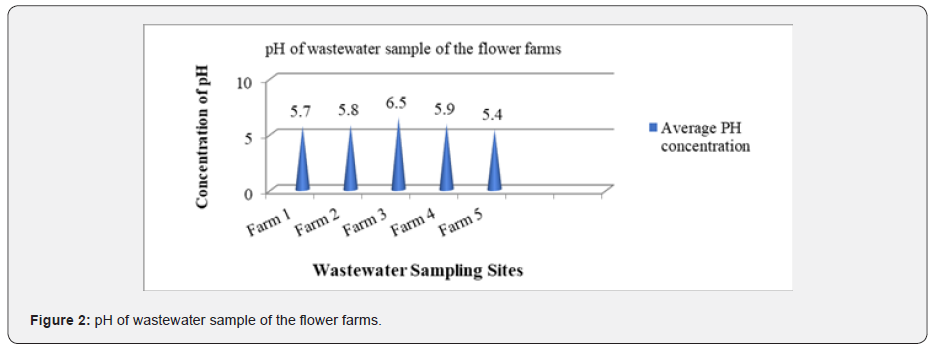
Electrical conductivity (EC)
Electrical conductivity (EC) is a measure of water capacity to convey electric current. The obtained mean concentration of the electrical conductivity (EC) of wastewater effluents of the selected flower farms were 3116.9, 3120, 2683.6, 17546.6 and 1489.7μScm-1 in the order of farm1, farm 2, farm 3, farm 4 and farm 5, respectively (Figure 3). As reported by Aniyikaiye et al. [13], high values of EC show that inorganic ions are in abundance in the wastewater. According to Benit & Roslin [14,15], ions are liberated from the decomposed plant matter and input of inorganic and organic waste materials.
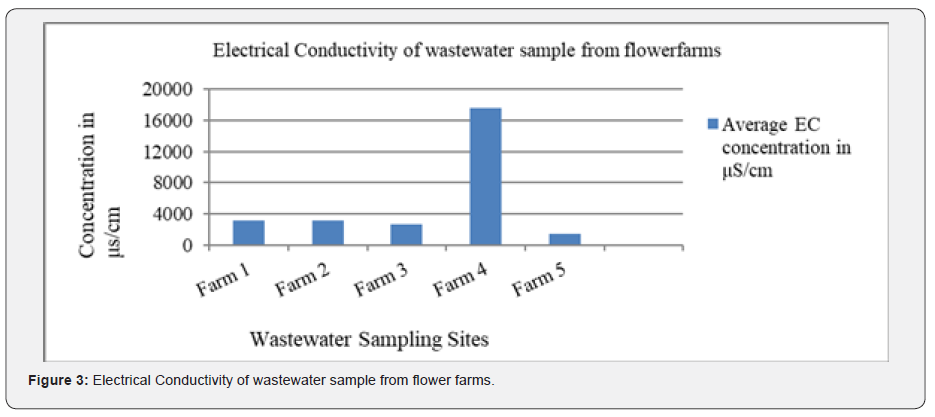
The optimum EC for wastewater discharge is 100-1000 μS/cm [8]. Thus, the results indicated that flower farms are discharging the wastewater with high amount of dissolved inorganic substances in ionized form from their agricultural activities to the environment. The source might be ions from fertilizers and pesticides.
Total dissolved solid (TDS)
Total dissolved solid is a measure of all dissolved substances in a wastewater. In other words, TDS is a measure of inorganic salts, organic matter, and other dissolved materials in water [11]. The measured mean value of total dissolved solid concentration in the wastewater effluents of the studied flower farms varied between a minimum value of 1117.5 mg/L at farm 5 to a maximum mean values of 13160 mg/L at farm 4 (Figure 4). The obtained values were much higher than the study conducted by Attah and Regassa [16], in the study for assessment of heavy metals in soil around a floriculture industry in Holeta.
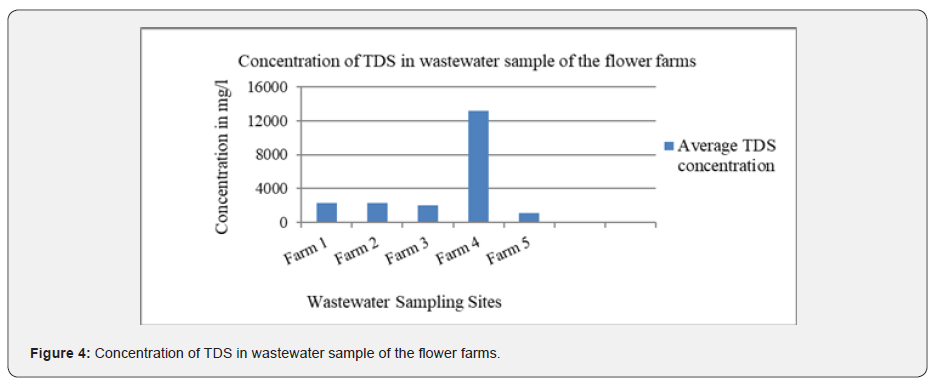
The recorded high TDS values of the wastewater effluents of the selected flower farms probably related to the high dissolved chemical components such as fertilizers and herbicides in the water which was used for irrigation purposes. As stated by EPA [9] higher TDS can be toxic to aquatic life through increases in salinity or changes in the composition of the water and also causes harmful effect to the public health.
Chemical oxygen demand (COD)
COD is a measure of the total quantity of oxygen required to oxidize all organic material into carbon dioxide and water. The measured mean COD values of the studied flower farms` wastewater varied from 11.2 to 339.2 mg/l (Figure 5). The minimum value was recorded at farm 2 and the maximum was at farm 3. High COD value is indication of organic pollution, and the number of organisms increase in the breaking down of organic substances, so the demand for oxygen increases proportionately. The highest mean COD values in this present study might be due to excessive organic and inorganic wastes in the farm’s wastewater effluent.
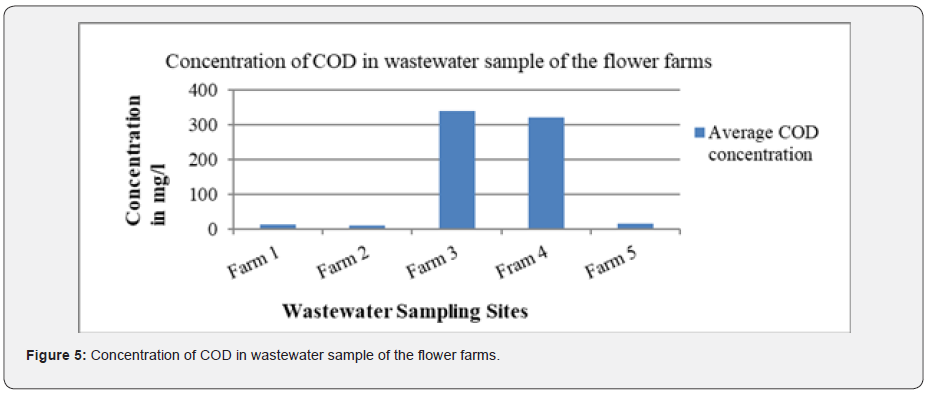
Sulphate (SO42-)
The mean sulphate ion concentration in the wastewater effluents of studied flower farms varied from a minimum of 35.1mg/L at farm 5 to a maximum of 716.0 mg/L farm 4 (Figure 6). Other values (40.0, 66.0, and 125.4 mg/L) obtained at farms1, 2 and 3, respectively. As stated by Tamiru & Leta [11], sulphate doses 14 to 29 mg/l have effect on humans, resulting in disturbance of the alimentary canal. The sources of sulphate ions in wastewater of flower farms might be sulphate containing chemical fertilizers.
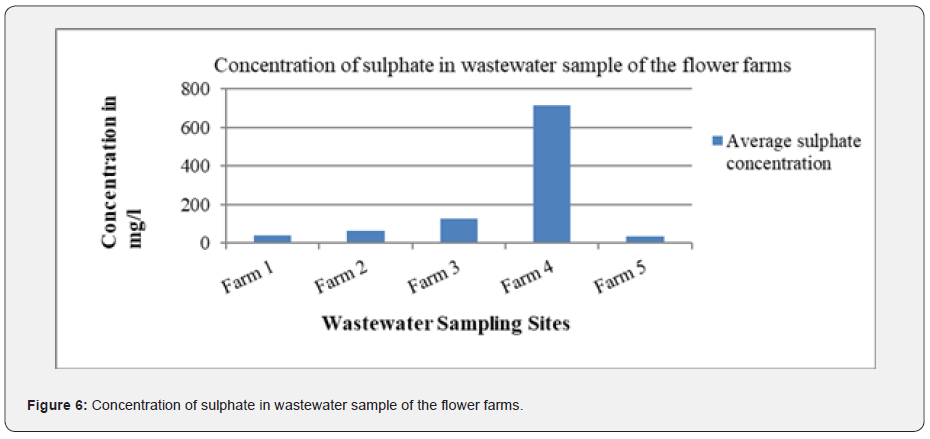
Phosphate (PO43-)
As it was shown by (Figure 7), the minimum mean concentration of phosphate 1.0 mg/L was obtained at farm5, and the maximum mean value 309.0 mg/L was at farm 4. The obtained maximum concentration of Phosphate recorded might be due to the flower farms high application of phosphate fertilizers. Because floricultures are known for using excessive fertilizers and the effluents from the farm drained directly to the nearby environments. According to Tamiru & Leta, [11,12], as the level of concentration of phosphates in wastewater effluent which enters the waterway increases; algae and aquatic plants will grow wildly and use up large amounts of oxygen which was higher indicating of eutrophication.
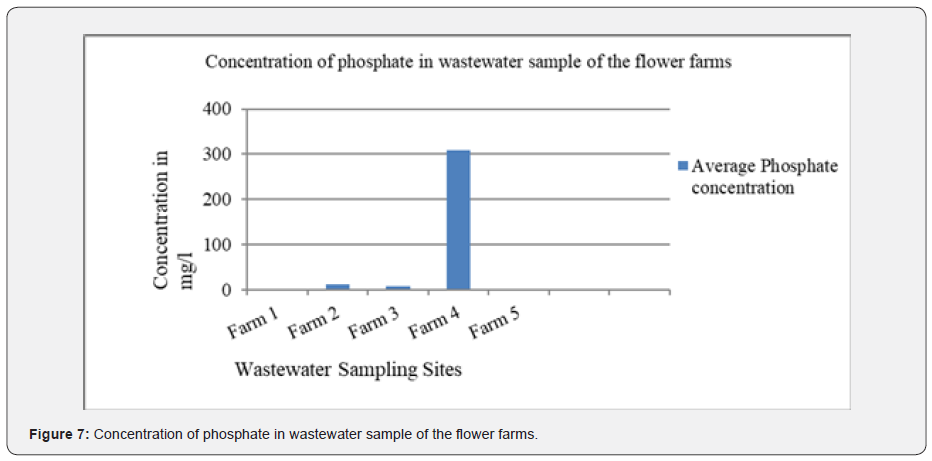
Heavy metal concentration of Soil samples
Lead (Pb)
In this study, except farm 2 (12.4 mg/kg), the mean concentration of lead was below detection limit for all analyzed soil samples taken from other flower farms. The detected value at farm 2 was higher than the result obtained by Washe [17], in the study to determine heavy metal concentration of floriculture around Lake Zeway.
Cobalt (Co)

The mean level of Co detected in the current studied flower farms soil samples was between 2.8-46.6 mg/kg. The lowest and highest values were found at farm 5 and farm 3, respectively (Figure 8) while the mean concentration detected in soils at farm1 and farm 4 was 37.2 mg/kg and 23.8 mg/kg, respectively. The mean Co content in this work was higher than those reported by Washe [17], in the study conducted to determine heavy metals contamination of the environment around Ziway Floriculture Industry and [13], in the assessment of heavy metals in soil around a floriculture industry in Holeta, Welmera wereda.
Zinc (Zn)
The results revealed that the concentration of zinc (Zn) was highest among the heavy metals analyzed from all the sample sites. The mean levels obtained were varied from 54.4 to 111.1 mg/kg. The value 54.4 mg/kg was found at farm 5 whereas 111.1 kg/mg was at farm 3 soil samples (Figure 9).

Conclusion
The experimental data obtained revealed that, high level of pollution was discharged into the environment by most of the flower farms. Most of the physicochemical parameters investigated exceeded the levels recommended for waste discharges by EPA. Getu, [1] stated that, if it is not well managed, whatever the farms put on the ground, sooner or later, will end up in the water or soil. Hence effluents generated by the firms are one of the major pollution sources of the water bodies.
The continuous pollution of water sources is a major problem, which is particularly devastating to rural communities that are directly dependent on untreated source water for all their domestic and other needs. To reduce pollution, there is need to ensure that wastewater is properly treated before discharge into the environment, routine monitoring and evaluation is also required to prevent the risk of contamination.
References
- Mulugeta Getu (2009) Ethiopian Floriculture and Its Impact on the Environment: Regulation, Supervision and Compliance. Mizan Law Review 3(2): 240–269.
- Abayneh Tilahun (2013) Environmental Impacts of Floriculture Industry in Debrezeit Town: A Need for Strategic Environmental Assessment Faculty of Technology-EiABC Addis Ababa University, Ethiopia.
- Arefaynie G (2009) Evaluation of Financial and operating performance of floriculture firms in Ethiopia A research project submitted to school of Graduate studies of Addis Ababa University in partial fulfillment for the requirement of M. Sc. degree in Accounting and Finance.
- APHA (American Public Health Association) (1998) Standard Methods for the examination of water and wastewater, 20th edition Washington, D.C.
- Bolo P, Brachet C (2010) Agricultural Non-Point Source Pollution. In Spatial Management of Risks pp. 39–70.
- Kassa M (2017) Review on Environmental Effects of Ethiopian Floriculture Industry. Asian Research Journal of Agriculture 4(2): 1-13.
- Tamiru (2007) Assessment of the ecological impacts of floriculture industries using physico-chemical parameters and benthic macroinvertebretes metric index along Wedecha River, Debrezeit, Ethiopia 6(7): 1-16.
- EHPEA (2014) Ethiopian Horticulture Producer Exporter Association (EHPEA). Export Horticulture in Ethiopia.
- Malidareh HB, Mahvi AH, Yunesian M, Alimohammadi M, Nazmara S (2014) Effect of Fertilizer Application on Paddy Soil Heavy Metals Concentration and Groundwater in North of Iran. Journal of Scientific Research, 20(12): 1721–1727.
- Ethiopoian Environmental Authority (EPA) & UNODO (2003) Guideline for Ambient Environment Standards.
- Tamiru, Leta (2017) Assessment of the ecological impacts of floriculture industries using physico-chemical parameters along Wedecha river, Debrezeit, Ethiopia. Water Utility Journal 15: 53-65.
- Malefia Tadele (2009) Environmental Impacts of Floriculture Industries on Lake Ziway: With particular reference to water quality, A Thesis Report Submitted to Addis Ababa University School of Graduate Studies as a Partial Fulfillment of MSc. Degree in Environmental Science.
- Aniyikaiye TE, Oluseyi T, Odiyo JO, Edokpayi JN (2019) Physico-Chemical Analysis of Wastewater Discharge from Selected Paint Industries in Lagos, Nigeria.
- Mateo Sagasta J, Marjani S, Turral H, Burke J (2017) Water pollution from agriculture: a global review. FAO IWMI, 35.
- Benit N, Roslin AS (2015) Physicochemical properties of wastewater collected from different sewage sources. IJISET-International Journal of Innovative Science, Engineering & Technology 2(11): 691-696.
- Attah L, Regasa M (2013) Assessment of heavy metals, pH and EC in effluent run-off, river and adjacent soil around a floriculture industry in Holeta, Wadera district, Ethiopia. Ethiopian Journal of Environmental Studies and Management 6(6).
- Washe (2018) Determination of Heavy Metals Contamination of the Environment Around Ziway Floriculture Industry. 58: 28-35.






























